+ Open data
Open data
- Basic information
Basic information
| Entry | Database: PDB / ID: 2axi | ||||||
|---|---|---|---|---|---|---|---|
| Title | HDM2 in complex with a beta-hairpin | ||||||
 Components Components |
| ||||||
 Keywords Keywords | LIGASE/LIGASE INHIBITOR / P53 / DRUG DESIGN / PROTEIN-PROTEIN INTERACTIONS / LIGASE / LIGASE-LIGASE INHIBITOR complex | ||||||
| Function / homology |  Function and homology information Function and homology informationcellular response to vitamin B1 / response to formaldehyde / response to water-immersion restraint stress / response to ether / traversing start control point of mitotic cell cycle / atrial septum development / regulation of protein catabolic process at postsynapse, modulating synaptic transmission / fibroblast activation / Trafficking of AMPA receptors / receptor serine/threonine kinase binding ...cellular response to vitamin B1 / response to formaldehyde / response to water-immersion restraint stress / response to ether / traversing start control point of mitotic cell cycle / atrial septum development / regulation of protein catabolic process at postsynapse, modulating synaptic transmission / fibroblast activation / Trafficking of AMPA receptors / receptor serine/threonine kinase binding / peroxisome proliferator activated receptor binding / negative regulation of intrinsic apoptotic signaling pathway by p53 class mediator / positive regulation of vascular associated smooth muscle cell migration / negative regulation of protein processing / SUMO transferase activity / response to steroid hormone / AKT phosphorylates targets in the cytosol / response to iron ion / NEDD8 ligase activity / atrioventricular valve morphogenesis / cellular response to peptide hormone stimulus / endocardial cushion morphogenesis / ventricular septum development / positive regulation of muscle cell differentiation / cardiac septum morphogenesis / regulation of postsynaptic neurotransmitter receptor internalization / blood vessel development / SUMOylation of ubiquitinylation proteins / ligase activity / cellular response to alkaloid / Constitutive Signaling by AKT1 E17K in Cancer / regulation of protein catabolic process / negative regulation of signal transduction by p53 class mediator / negative regulation of DNA damage response, signal transduction by p53 class mediator / SUMOylation of transcription factors / response to magnesium ion / cellular response to UV-C / protein sumoylation / cellular response to actinomycin D / cellular response to estrogen stimulus / blood vessel remodeling / protein localization to nucleus / ribonucleoprotein complex binding / protein autoubiquitination / positive regulation of vascular associated smooth muscle cell proliferation / NPAS4 regulates expression of target genes / transcription repressor complex / positive regulation of mitotic cell cycle / regulation of heart rate / proteolysis involved in protein catabolic process / positive regulation of protein export from nucleus / ubiquitin binding / response to cocaine / DNA damage response, signal transduction by p53 class mediator / Stabilization of p53 / establishment of protein localization / Regulation of RUNX3 expression and activity / cellular response to gamma radiation / Oncogene Induced Senescence / RING-type E3 ubiquitin transferase / protein destabilization / Regulation of TP53 Activity through Methylation / cellular response to growth factor stimulus / response to toxic substance / centriolar satellite / cellular response to hydrogen peroxide / protein polyubiquitination / ubiquitin-protein transferase activity / disordered domain specific binding / p53 binding / ubiquitin protein ligase activity / endocytic vesicle membrane / Signaling by ALK fusions and activated point mutants / Regulation of TP53 Degradation / positive regulation of proteasomal ubiquitin-dependent protein catabolic process / negative regulation of neuron projection development / 5S rRNA binding / protein-containing complex assembly / ubiquitin-dependent protein catabolic process / Oxidative Stress Induced Senescence / cellular response to hypoxia / Regulation of TP53 Activity through Phosphorylation / amyloid fibril formation / proteasome-mediated ubiquitin-dependent protein catabolic process / regulation of cell cycle / Ub-specific processing proteases / postsynaptic density / protein ubiquitination / response to xenobiotic stimulus / protein domain specific binding / response to antibiotic / negative regulation of DNA-templated transcription / positive regulation of cell population proliferation / apoptotic process / ubiquitin protein ligase binding / positive regulation of gene expression / negative regulation of apoptotic process / nucleolus / glutamatergic synapse / enzyme binding Similarity search - Function | ||||||
| Biological species |  Homo sapiens (human) Homo sapiens (human) | ||||||
| Method |  X-RAY DIFFRACTION / X-RAY DIFFRACTION /  MOLECULAR REPLACEMENT / Resolution: 1.4 Å MOLECULAR REPLACEMENT / Resolution: 1.4 Å | ||||||
 Authors Authors | Mittl, P.R.E. / Fasan, R. / Robinson, J. / Gruetter, M.G. | ||||||
 Citation Citation |  Journal: Chembiochem / Year: 2006 Journal: Chembiochem / Year: 2006Title: Structure-Activity Studies in a Family of beta-Hairpin Protein Epitope Mimetic Inhibitors of the p53-HDM2 Protein-Protein Interaction. Authors: Fasan, R. / Dias, R.L. / Moehle, K. / Zerbe, O. / Obrecht, D. / Mittl, P.R. / Robinson, J.A. | ||||||
| History |
|
- Structure visualization
Structure visualization
| Structure viewer | Molecule:  Molmil Molmil Jmol/JSmol Jmol/JSmol |
|---|
- Downloads & links
Downloads & links
- Download
Download
| PDBx/mmCIF format |  2axi.cif.gz 2axi.cif.gz | 41.2 KB | Display |  PDBx/mmCIF format PDBx/mmCIF format |
|---|---|---|---|---|
| PDB format |  pdb2axi.ent.gz pdb2axi.ent.gz | 26.9 KB | Display |  PDB format PDB format |
| PDBx/mmJSON format |  2axi.json.gz 2axi.json.gz | Tree view |  PDBx/mmJSON format PDBx/mmJSON format | |
| Others |  Other downloads Other downloads |
-Validation report
| Summary document |  2axi_validation.pdf.gz 2axi_validation.pdf.gz | 446.1 KB | Display |  wwPDB validaton report wwPDB validaton report |
|---|---|---|---|---|
| Full document |  2axi_full_validation.pdf.gz 2axi_full_validation.pdf.gz | 449.4 KB | Display | |
| Data in XML |  2axi_validation.xml.gz 2axi_validation.xml.gz | 5.9 KB | Display | |
| Data in CIF |  2axi_validation.cif.gz 2axi_validation.cif.gz | 7.7 KB | Display | |
| Arichive directory |  https://data.pdbj.org/pub/pdb/validation_reports/ax/2axi https://data.pdbj.org/pub/pdb/validation_reports/ax/2axi ftp://data.pdbj.org/pub/pdb/validation_reports/ax/2axi ftp://data.pdbj.org/pub/pdb/validation_reports/ax/2axi | HTTPS FTP |
-Related structure data
| Related structure data |  1ycrS S: Starting model for refinement |
|---|---|
| Similar structure data |
- Links
Links
- Assembly
Assembly
| Deposited unit | 
| ||||||||||||
|---|---|---|---|---|---|---|---|---|---|---|---|---|---|
| 1 |
| ||||||||||||
| 2 | 
| ||||||||||||
| 3 | 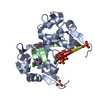
| ||||||||||||
| 4 | 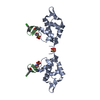
| ||||||||||||
| 5 | 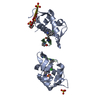
| ||||||||||||
| Unit cell |
| ||||||||||||
| Components on special symmetry positions |
|
- Components
Components
| #1: Protein | Mass: 13364.231 Da / Num. of mol.: 1 / Fragment: HDM2 Source method: isolated from a genetically manipulated source Source: (gene. exp.)  Homo sapiens (human) / Gene: MDM2 / Plasmid: pET14b / Production host: Homo sapiens (human) / Gene: MDM2 / Plasmid: pET14b / Production host:  References: UniProt: Q9UMT8, UniProt: Q00987*PLUS, Ligases; Forming carbon-nitrogen bonds; Acid-amino-acid ligases (peptide synthases) | ||||||
|---|---|---|---|---|---|---|---|
| #2: Protein/peptide | 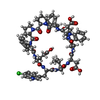  Type: Peptide-like / Class: Inhibitor / Mass: 1399.930 Da / Num. of mol.: 1 / Source method: obtained synthetically / Details: The peptide was synthesized. Type: Peptide-like / Class: Inhibitor / Mass: 1399.930 Da / Num. of mol.: 1 / Source method: obtained synthetically / Details: The peptide was synthesized.References: cyclo(L-alpha-aspartyl-L-tryptophyl-L-alpha-glutamyl-L-phenylalanyl-D-prolyl-L-prolyl-L-phenylalanyl-L-alpha-glutamyl-6 -chloro-L-tryptophyl-L-leucyl) | ||||||
| #3: Chemical | | #4: Chemical | ChemComp-MPO / | #5: Water | ChemComp-HOH / | Has protein modification | Y | |
-Experimental details
-Experiment
| Experiment | Method:  X-RAY DIFFRACTION / Number of used crystals: 1 X-RAY DIFFRACTION / Number of used crystals: 1 |
|---|
- Sample preparation
Sample preparation
| Crystal | Density Matthews: 1.82115 Å3/Da / Density % sol: 32.460266 % Description: Data was collected in-house and at the synchrotron |
|---|---|
| Crystal grow | Temperature: 293 K / Method: vapor diffusion, hanging drop / pH: 5.5 Details: MES, ammonium sulfate, pH 5.5, VAPOR DIFFUSION, HANGING DROP, temperature 293K |
-Data collection
| Diffraction | Mean temperature: 100 K |
|---|---|
| Diffraction source | Source:  ROTATING ANODE / Type: ENRAF-NONIUS FR571 / Wavelength: 1.54 Å ROTATING ANODE / Type: ENRAF-NONIUS FR571 / Wavelength: 1.54 Å |
| Detector | Type: MARRESEARCH / Detector: IMAGE PLATE / Date: Oct 1, 2003 / Details: Osmic Mirrors |
| Radiation | Protocol: SINGLE WAVELENGTH / Monochromatic (M) / Laue (L): M / Scattering type: x-ray |
| Radiation wavelength | Wavelength: 1.54 Å / Relative weight: 1 |
| Reflection | Resolution: 1.4→50 Å / Num. obs: 21288 / % possible obs: 98.4 % / Observed criterion σ(I): 0 / Redundancy: 4.18 % / Rmerge(I) obs: 0.09 / Net I/σ(I): 15.19 |
| Reflection shell | Resolution: 1.4→1.41 Å / Redundancy: 3.9 % / Rmerge(I) obs: 0.48 / Mean I/σ(I) obs: 2.91 / % possible all: 90.8 |
- Processing
Processing
| Software |
| ||||||||||||||||||||||||||||
|---|---|---|---|---|---|---|---|---|---|---|---|---|---|---|---|---|---|---|---|---|---|---|---|---|---|---|---|---|---|
| Refinement | Method to determine structure:  MOLECULAR REPLACEMENT MOLECULAR REPLACEMENTStarting model: 1YCR Resolution: 1.4→10 Å / σ(F): 4 / Stereochemistry target values: ENGH & HUBER
| ||||||||||||||||||||||||||||
| Refinement step | Cycle: LAST / Resolution: 1.4→10 Å
|
 Movie
Movie Controller
Controller



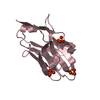
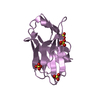
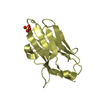
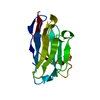
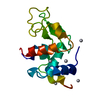




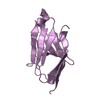
 PDBj
PDBj















